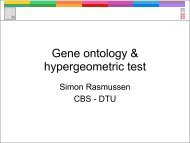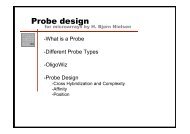Computational tools and Interoperability in Comparative ... - CBS
Computational tools and Interoperability in Comparative ... - CBS
Computational tools and Interoperability in Comparative ... - CBS
Create successful ePaper yourself
Turn your PDF publications into a flip-book with our unique Google optimized e-Paper software.
Tümmler, 2004). Genomic regions termed the ‘core<br />
sequences’ are characterized by OU patterns be<strong>in</strong>g<br />
similar to the global pattern of the chromosome. However,<br />
many loci with alternative OU patterns typically contribute<br />
to <strong>in</strong> total more than 10% of a bacterial genome. These<br />
loci with atypical OU patterns comprise heterogeneous<br />
subsets of parasitic <strong>and</strong> recent foreign DNA, ancient<br />
genes for ribosomal constituents (RNAs <strong>and</strong> prote<strong>in</strong>s),<br />
multidoma<strong>in</strong> genes <strong>and</strong> non-cod<strong>in</strong>g sequences with multiple<br />
t<strong>and</strong>em repeats (Reva <strong>and</strong> Tümmler, 2005). Hence<br />
laterally transferred gene isl<strong>and</strong>s can be reliably identified<br />
<strong>in</strong> complete genomes by their atypical oligonucleotide<br />
usage (Reva <strong>and</strong> Tümmler, 2005; Chen et al., 2007;<br />
Klockgether et al., 2007). Here, we focused on tetranucleotide<br />
usage (TU) parameters because the 256 different<br />
tetranucleotide words are optimal to differentiate bacterial<br />
genome sequences by the frequency <strong>and</strong> <strong>in</strong>formativeness<br />
of the <strong>in</strong>dividual element. TU patterns represent the deviations<br />
of tetranucleotide word counts <strong>in</strong> a given sequence<br />
from an equiprobable distribution. Selection <strong>and</strong> counterselection<br />
of the oligonucleotide words are driven by their<br />
<strong>Comparative</strong> genomics of Alcanivorax borkumensis 3<br />
Fig. 2. Phylome Atlas of A. borkumensis SK2 genes <strong>in</strong>dicat<strong>in</strong>g their closest bacterial homologues. Each of the concentric circles represents a<br />
taxonomic group as described <strong>in</strong> the figure legend on the right, with the outermost circle correspond<strong>in</strong>g to the top-most feature, <strong>and</strong> the<br />
<strong>in</strong>nermost circle correspond<strong>in</strong>g to the bottom-most feature. Light b<strong>and</strong>s <strong>in</strong>dicate A. borkumensis SK2 genes with no homologue <strong>in</strong> the<br />
respective taxonomic group.<br />
stereochemical properties such as base stack<strong>in</strong>g energy,<br />
propeller twist angle, prote<strong>in</strong> deformability, bendability<br />
<strong>and</strong> position preference (Reva <strong>and</strong> Tümmler, 2004). By<br />
permutation analysis, the 256 tetranucleotides were<br />
assigned to 39 equivalence classes each of which characterized<br />
by the same values for the five properties mentioned<br />
above (Baldi <strong>and</strong> Baisnee, 2000). Words of the<br />
same equivalence class tend to occur at similar frequencies<br />
<strong>in</strong> a nucleotide sequence (Reva <strong>and</strong> Tümmler, 2004).<br />
Oligonucleotide usage conservation reflects to some<br />
extent the phylogeny of microorganisms (Pride et al.,<br />
2003; Teel<strong>in</strong>g et al., 2004).<br />
Phylogenomics by tetranucleotide usage analysis<br />
TU patterns were calculated for all sequenced genomes<br />
of g-Proteobacteria. Four examples of TU patterns determ<strong>in</strong>ed<br />
for A. borkumensis SK2, Pseudomonas putida<br />
KT2440, Escherichia coli K-12 <strong>and</strong> Shewanella oneidensis<br />
MR-1 are shown <strong>in</strong> Fig. 3. Tetranucleotide words were<br />
grouped by the equivalence classes <strong>and</strong> sorted <strong>in</strong> order of<br />
©2007TheAuthors<br />
Journal compilation © 2007 Society for Applied Microbiology <strong>and</strong> Blackwell Publish<strong>in</strong>g Ltd, Environmental Microbiology









